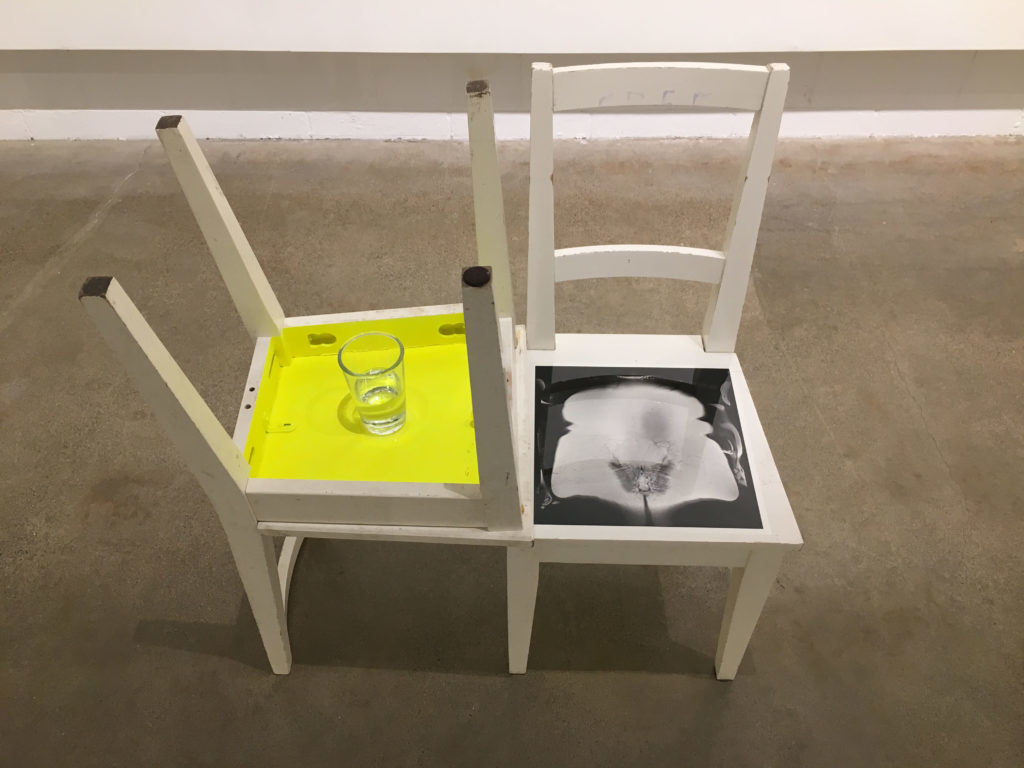Betsy Alwin and Shana Kaplow: Uncertain Structures, The Small Parts
Review II by Alexis Zanghi
Rosalux Gallery
Aug 4–26, 2018

In the early 2010s, home design blogs became fixated with faux finishes. With the same breathy enthusiasm used to confess to something like shoplifting or wearing SPANX, Instagram influencer how-to’s advised applying marble contact paper and rose gold spray paint to virtually every item in the IKEA catalogue. Like supportive undergarments, the goal was the lie—a cheap imitation of one’s “social betters,” something that Thorstein Veblen called “pecuniary emulation.”
Such domestic deceit finds itself inverted and deployed to more strategic ends in Betsy Alwin’s “Uncertain Structures”. In Lightness of Being, flocked rebar velveteens itself into long burgundy ropes that could hang between stanchions at a private club or museum; an anvil is coated with foam; porcelain is cast into the shape of an arm (its hand halfway to a fist), then glazed in a cobalt and white pattern that’s evocative of the chinoiserie patterns popularized by the Dutch East India Company and others in seventeenth and eighteenth century Europe. Among the clearest instances of another Veblen term, cultural appropriation, chinoiserie mimics the porcelain patterns associated with several dynasties within Imperial China, with an orientalist disregard for exactitude and a colonial enthusiasm for other-ness. In Alwin’s works the shapes the blue and white literally glosses over are sinister, ready to be deployed as tools of destruction or exclusion. Beyond the rebar ropes and the anvil and the half-closed fist, another installation assembles porcelain bricks, ready for throwing; editioned multiples in the Rosalux shop cast the same porcelain as guns and hammers. In alluding to chinoiserie patterns—ossified as petit bourgeois domestic canon—Alwin implicates both the practitioner and the viewer, as each shining surface and hard edge points to the violence that undergirds ornamentation.
In “The Small Parts”, a more intimate strain of violence emerges as Shana Kaplow’s transparencies and works on paper are subsumed by their own gloss and softness. Anabolic reconfigures two Shaker chairs—white-washed and damaged—as a child’s fort, with one chair left upright. In its seat lies a black and grey transparency, the shadows and shapes converging at the center into a slick Rorschach test. It is difficult for the viewer to tell whether what is in the seat is a mouth or a womb or a wound. Despite the ambiguity of what is being depicted and the delicate structure in which it’s sited, the image is visceral and vulnerable. Nearby, silhouettes of the chair careen across a wall, its edges growing soft in the dark, eventually leading to a small, ambiguous gesture at the exhibition’s coda—a malformed circle, a hopeful horseshoe, or an ear, washed onto the wall in what appears to be a single stroke. “The Small Parts” feels at once clinical and deeply personal. Here, veneer is something that illuminates rather than obfuscates, and the effect on the viewer is uncanny and disorienting.
There’s a discursive femininity at work, one that twins confession and confrontation. “The Small Parts”’ frankness is disorienting, in the same way the fluorescent lighting of a dressing room or gynecologist’s office might be: we know what’s coming, and we know it will hurt. Kaplow’s work seems ready to dissolve in its sheen, and in doing so, implicates the viewer as a witness to its own destruction. Alwin approaches these concerns from a structural, macro perspective, challenging the viewer to consider their own role and siting within systemic violence. An affective environment of trauma pervades the gallery, populated as it is with disembodied parts, glittering and shining like last night’s makeup, as both artists ask: at what cost comes the gloss? How soft is your anvil?
